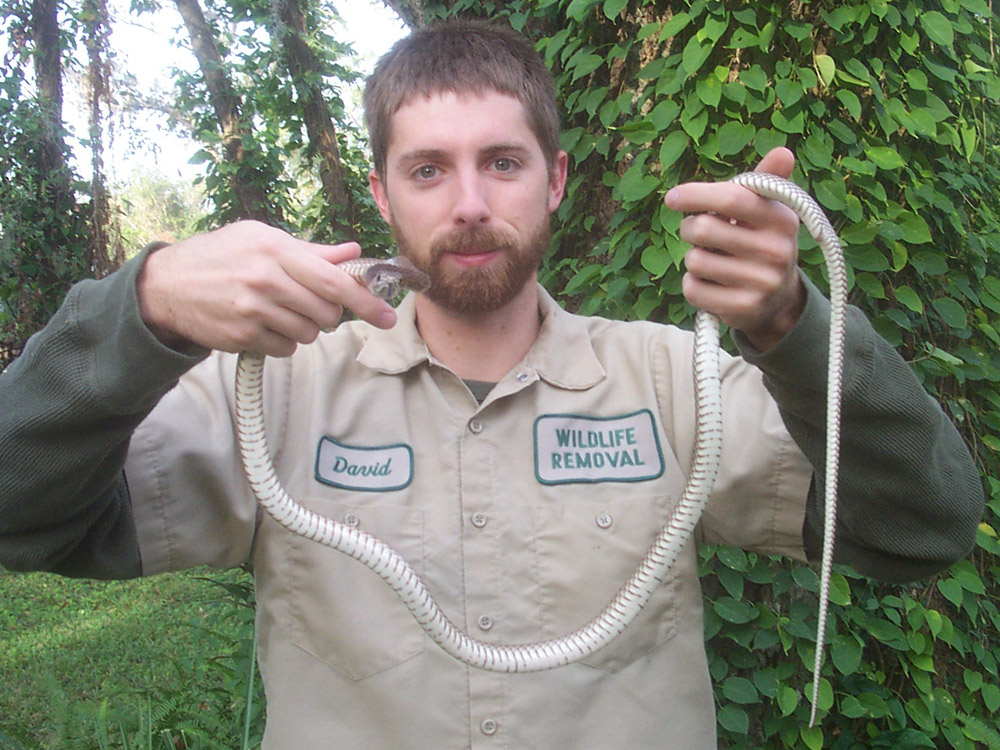|

 |
The Coachwhip is an incredibly fast snake - I've only caught 2. |
 |
DESCRIPTION: A light brown
snake, with hints of purple, even, and a white belly. It's
very thin, and very fast.
If you need snake removal in your town, click for the National Directory of
Snake Removal Companies that I've carefully compiled in every USA city.
Coachwhips reach more than 8 feet in length and are fairly thin. Their eye sight is excellent and their color is unique, the adults’ head is black and as the color moves down their body it fades to brown, then tan, and its tail is nearly white at times. Young coachwhips are wholly tan and extremely slender. They get their name from the distinctive pattern on their tails that looks like a braided bull whip.
Coachwhips can be found in the southern United States in a line from southeastern North Carolina to central California. They do not reside in mountainous regions on the whole.
They enjoy living in places with sandy soil like coastal areas, and open habitats with sandy soil including coastal dunes, sand hill scrubs, open pine forests, and prairies. They roam their chosen habitat during the day in search of food. The hotter the day, the more likely you are to see one. As they hunt, their head is high off the ground.
They eat insects, lizards, birds, rodents, and other small animals. Coachwhips are extremely fast snakes. They have been known to catch racerunners and skinks; not an easy task. Instead of constricting their prey it is eaten alive.
While they are primarily earth dwelling snakes, they will take off in a flash if alarmed and climb a tree or hide in a bush for safety. If you catch a coachwhip there is no way to know if it will bite you or not. Some are aggressive and bite quickly while others hide their heads or even go limp.
Fun Fact: Some people believe the coachwhip got its name because it chases and attacks humans by beating (whipping) them with its tail. While it is an interesting theory, the reality is that it is completely untrue. If it did that it would snap its own back and die.
Running a wildlife removal business in the state of Florida gives me the chance to see all kinds of interesting snakes! Florida has about 45 species of snake, and I've seen 29 of them so far. I've always got my eye out for new species, and
I love spotting rare snakes in Florida. I also have a thing for venomous snakes - they're not too common in FL, so I always enjoy the chance to see a poisonous serpent. I really like snakes, and I've never hurt or killed one. They're an
important part of the ecosystem, and often persecuted. Still, if you don't want snakes in your house or on your property, and judging from the number of phone calls I receive regarding snake problems, you don't, then give me or a local snake
expert in your area a call, and we can remove the snakes from your property for you. I use many snake control methods - from snake traps, to snake repellents, to habitat modification, but most of all, good old-fashioned capture and removal.
If you want to learn more, please read my How To Get Rid of Snakes page.
AAAnimal Control is a privately owned wildlife removal and pest control business, located in Orlando Florida. I deal strictly with wild animals including snakes inside houses. I am not an extermination company, but a critter removal
and control specialist. The above photos are some of the many that I've taken in the field over my years of work. Please email me if
you have any questions about the above photographs, or any questions about
wildlife problems or Florida snake removal issues.
You can safely catch snakes with a special trap, which you can order by clicking this banner:

|
| |
|